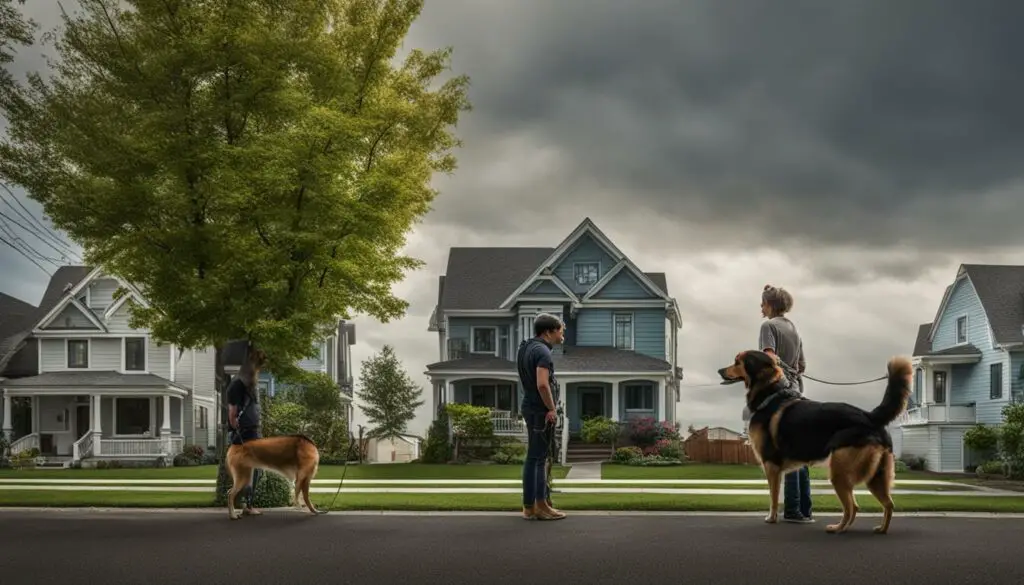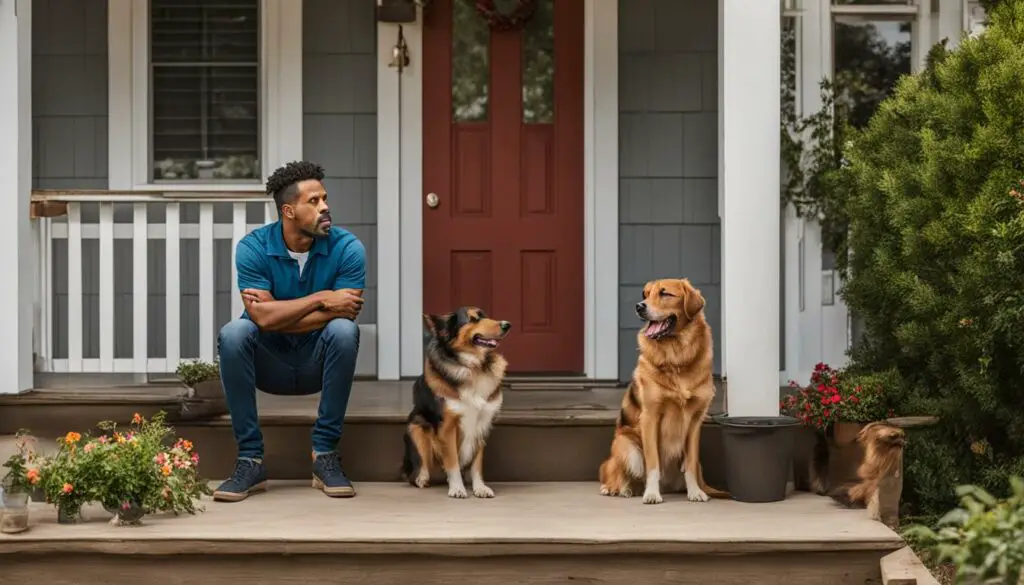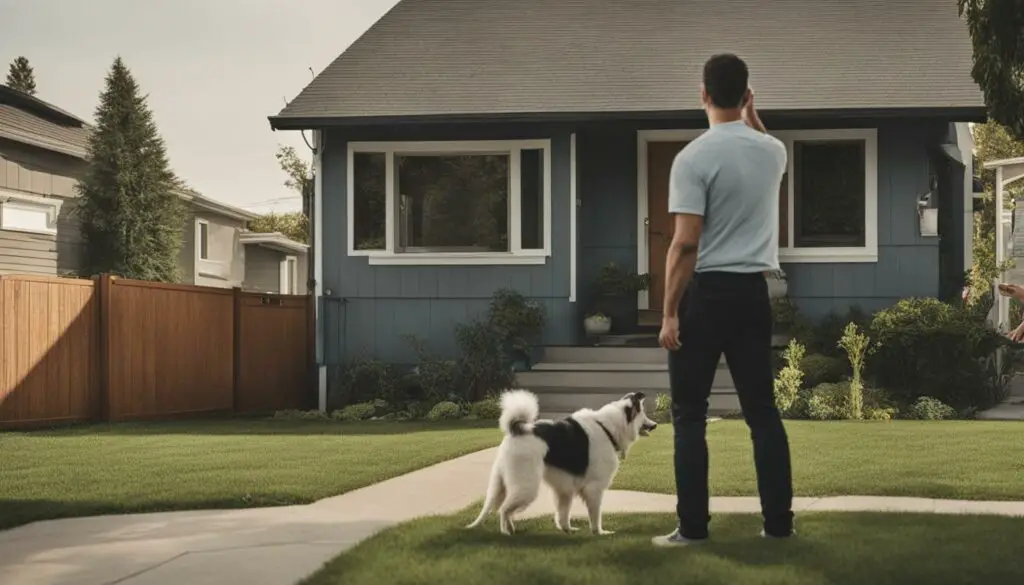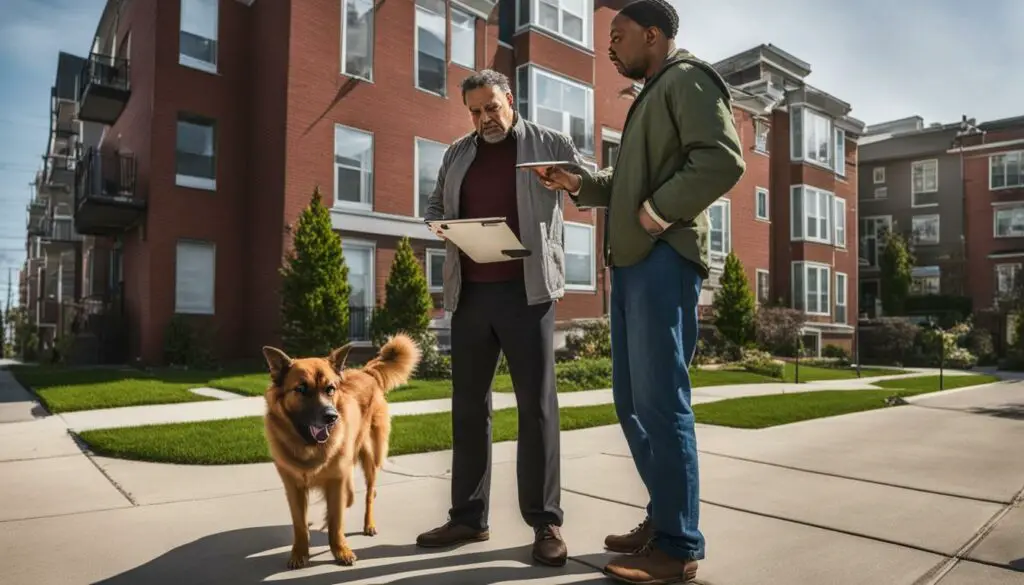If you’re facing a situation where your neighbor is harassing you about your dog, it can be a stressful and difficult challenge. In this guide, we will explore practical strategies to resolve pet disputes with your neighbor, including understanding your rights as a pet owner and neighbor, having open and honest conversations, setting boundaries, involving your landlord, and considering legal action as a last resort.
Key Takeaways:
- Understanding your rights as a pet owner and neighbor is crucial in resolving neighbor harassment.
- Initiating a calm and open conversation with your neighbor can help find a mutually beneficial solution.
- Setting clear boundaries and implementing proactive measures can protect your pet and address your neighbor’s concerns.
- Involving your landlord may be necessary if the harassment persists despite your efforts.
- Legal action should be considered as a last resort, with proper documentation and evidence to support your case.
Understanding Your Rights as a Pet Owner
As a responsible pet owner, it is vital to know and understand your rights regarding your beloved companion. Familiarize yourself with the local laws and regulations related to pet ownership in your area. This includes understanding registration requirements, vaccination protocols, and any specific rules that govern pet behavior and responsibilities.
By being aware of these laws, you can ensure that you are meeting all the necessary legal obligations as a pet owner. It also helps you protect your rights in case of any conflicts or disputes with your neighbor. Document any incidents or instances of harassment that you may experience, as these records can serve as evidence in the future if needed.
| Local Laws and Regulations | Pet Owner Rights | Harassment Rights |
|---|---|---|
| Registering your pet | Ensuring your pet’s well-being | Protection from neighbor harassment |
| Vaccination requirements | Exercising your pet in designated areas | Seeking legal remedies if necessary |
| Leash laws | Providing proper care and shelter | Preserving the peace and enjoyment of your home |
Understanding your rights as a pet owner empowers you to handle any conflicts that may arise effectively. It also allows you to confidently address any concerns raised by your neighbor, ensuring a harmonious coexistence between you, your pet, and your community.
Understanding Your Rights as a Neighbor
When dealing with conflicts and disputes with your neighbor, it is crucial to understand your rights. Familiarizing yourself with neighbor laws and regulations will help you navigate the situation effectively and make informed decisions. Here are some key aspects to consider:
1. Property boundaries and zoning regulations
Knowing the exact boundaries of your property and understanding the zoning regulations in your area is essential. This knowledge will help you address any potential issues related to encroachments or unauthorized use of your property by your neighbor.
2. Noise regulations and disturbance
Most jurisdictions have noise regulations in place to ensure peaceful coexistence among neighbors. Educate yourself on these regulations, such as specific quiet hours during the day, to address any noise complaints or disturbances from your neighbor.
3. Right to privacy and peaceful enjoyment
As a neighbor, you have the right to privacy and peaceful enjoyment of your property. This means that your neighbor should not engage in activities that invade your privacy, cause nuisance, or disturb your peaceful living environment.
4. Shared common areas and responsibilities
If you share common areas with your neighbor, such as driveways, fences, or walls, it’s important to understand the rights and responsibilities associated with them. Set clear expectations and boundaries to prevent any conflicts or disputes regarding the maintenance or use of these shared spaces.
By understanding your rights as a neighbor, you can effectively address conflicts and disputes, fostering a harmonious relationship with those around you.
Initiating a Conversation with Your Neighbor
Resolving conflicts with a neighbor begins with open communication. Initiating a calm and friendly conversation with your neighbor is an important step towards finding a resolution to the issue at hand. Express your concerns and explain how their behavior is causing distress, emphasizing the importance of your pet in your life. Highlight your pet’s good behavior and proper care. This approach can help your neighbor understand the positive impact your pet brings to your life and foster empathy.
During the conversation, it’s essential to listen actively and show a willingness to find a mutually beneficial solution. Ask for their suggestions on how to resolve the situation. By involving your neighbor in the problem-solving process, you demonstrate a collaborative mindset. This approach can create a sense of ownership for both parties, increasing the likelihood of finding a resolution that works for everyone.
Creating a Safe and Non-Confrontational Environment
When initiating a conversation, it’s crucial to create a safe and non-confrontational environment. Choose a neutral location, such as a common area or a public space, to avoid any perception of intrusion or territoriality. Approach the conversation with a calm demeanor and keep your tone respectful. This will help reduce tension and facilitate a constructive dialogue.
Remember to maintain an open mind and be prepared to address any concerns your neighbor may raise. Listen attentively to their perspective and validate their feelings. Acknowledging their concerns can help create a more empathetic atmosphere, where both parties are more likely to work towards a resolution.
Throughout the conversation, avoid blaming or accusing language. Instead, focus on finding common ground and exploring potential solutions together. This approach promotes open communication and increases the chances of finding a mutually satisfactory resolution to the conflict.

Sample Conversation Starter:
Neighbor, I wanted to talk to you about our recent interactions regarding my dog. I value our relationship and would like to find a solution that works for both of us. My dog is an important part of my life, and I understand that his behavior may have caused some concerns. I believe open communication is key to resolving any tensions and finding a way to coexist harmoniously. I’d appreciate your thoughts and suggestions on how we can address this situation amicably.”
Setting Boundaries to Protect Your Pet
Protecting your pet and minimizing complaints from your neighbor is essential for maintaining a harmonious living environment. Setting clear boundaries is key to ensuring that both your pet’s needs and your neighbor’s concerns are addressed. By implementing proactive measures, you can create a peaceful atmosphere for everyone involved.
Establishing Physical Boundaries
One effective way to protect your pet is by establishing physical boundaries. This includes installing a secure fence that prevents your dog from wandering onto your neighbor’s property. A sturdy fence not only keeps your pet safe but also provides peace of mind to both you and your neighbor. Additionally, consider creating a designated area within your property where your pet can play and exercise without causing disturbance.
Addressing Noise Concerns
Noise complaints are a common issue when it comes to pets. To minimize noise-related conflicts with your neighbor, consider using noise-cancelling collars for your dog or implementing behavioral training. Training your pet to respond to commands and reducing excessive barking can significantly reduce noise disruptions, ensuring a more peaceful environment for both you and your neighbor.
Respecting Community Regulations
Be aware of any community regulations or homeowner association rules regarding pet ownership. Adhere to these guidelines to avoid any conflicts with your neighbor. By respecting these regulations, you demonstrate your commitment to being a responsible pet owner and a considerate neighbor.
Remember, open communication, mutual respect, and understanding are essential when setting boundaries with your neighbor. By taking proactive steps to address any concerns and protect your pet, you can foster a positive relationship and create a peaceful coexistence.
Involving Your Landlord
If your efforts to resolve the neighbor harassment issue have been unsuccessful, it may be necessary to involve your landlord in the situation. Your landlord can provide guidance and support, as well as potentially enforce any rules and policies that are in place to address neighbor disputes. By informing your landlord about the ongoing harassment, you can seek their intervention to help mediate the situation or take appropriate action if needed.
When approaching your landlord, clearly explain the problem and provide any evidence or documentation you have collected regarding the neighbor’s behavior. This can include written complaints, records of confrontations, or instances of aggression towards you or your dog. By presenting a clear case, you can demonstrate the seriousness of the issue and the impact it is having on your living situation.
Your landlord may have specific rules and policies in place to handle neighbor disputes. They may be able to communicate with your neighbor and remind them of their responsibilities as a tenant. In some cases, your landlord may issue warnings or even take legal action against the harassing neighbor. Remember to keep your landlord updated on any further incidents or developments, as their involvement can play a crucial role in finding a resolution.
Considering Legal Action
When all attempts to resolve the issue of neighbor harassment about your dog have failed, it may be necessary to consider taking legal action as a last resort. This step should only be taken after exploring all other options and consulting with the appropriate authorities.
If you find yourself in a situation where the harassment persists and is negatively impacting your life, it’s essential to seek advice from the local authorities, such as the police or animal welfare organization. They can provide guidance on how to proceed and may advise you to file a complaint against your neighbor.
When preparing to take legal action, it’s crucial to gather any necessary evidence or documentation that supports your case. This may include records of incidents, witness testimonies, and any communication or interaction with your neighbor regarding the issue. Presenting a strong case will increase your chances of getting a resolution in your favor.
| Steps to Consider When Taking Legal Action | |
|---|---|
| Gather all relevant evidence | |
| Consult with local authorities | |
| File a complaint if necessary | |
| Seek legal advice if needed |
Remember, legal action should be considered as a last resort. It’s always best to try and resolve issues through open communication and peaceful means. However, in some cases, taking legal action may be the only way to protect yourself and your pet from ongoing harassment.
By following the appropriate legal procedures and seeking the necessary support, you can find a resolution to the issue of neighbor harassment. Remember, the ultimate goal is to create a safe and peaceful living environment for yourself and your beloved pet.

Understanding the Reasons Behind Neighbor Harassment
Neighbor harassment can arise from various pet-related issues and nuisance behavior that can disrupt the peace and harmony of the community. By understanding the reasons behind neighbor harassment, you can address specific concerns raised by your neighbor and find appropriate solutions.
Pet-related issues
One common reason for neighbor harassment is pet-related issues. Dogs that pester people, bark excessively, or display aggressive behavior can be sources of frustration for neighbors. Additionally, if your dog trespasses onto your neighbor’s property or causes damage to their belongings, it can lead to strained relationships and potential conflicts.
Nuisance behavior
Nuisance behavior, such as excessive noise or inappropriate urination/defecation, can also contribute to neighbor harassment. Constant barking, howling, or loud noises caused by your dog can disturb the peace and quiet of the neighborhood. Similarly, if your dog regularly eliminates in inappropriate areas, it can create unsanitary conditions and offend your neighbors.
By recognizing these reasons and understanding the impact they have on your neighbors, you can take appropriate measures to address the concerns and prevent future conflicts. Open communication, responsible pet ownership, and proactive training can help create a more peaceful coexistence with your neighbors and ensure a harmonious living environment for everyone involved.

Note: Neighbor harassment can be a complex issue, and the specific reasons may vary depending on the circumstances. It’s important to assess your particular situation and take appropriate steps to address the concerns raised by your neighbor.
Dealing with Complaints about Your Dog’s Behavior
When your neighbor complains about your dog’s behavior, it’s important to address their concerns in a respectful manner. By taking the initiative to understand and modify your dog’s behavior, you can alleviate their worries and foster a better relationship with your neighbor.
One effective approach is to invest in training and socialization for your dog. Professional training can help address specific behavioral issues and teach your dog appropriate behaviors. Socializing your dog with other animals and people can also help them become more well-behaved and less likely to cause disturbances.
Additionally, consider implementing measures to minimize any disruptions your dog may cause. For example, if your dog tends to bark excessively, you can train them to be quieter or use noise-cancelling devices. Taking responsibility for your pet’s actions and making adjustments shows your neighbor that you are taking their concerns seriously.
| Addressing Complaints About Your Dog’s Behavior |
|---|
| Invest in professional training to address specific behavioral issues |
| Socialize your dog with other animals and people |
| Implement measures to minimize disruptions caused by your dog |
Open and ongoing communication with your neighbor is crucial throughout this process. Regularly check in with them to ensure that their concerns are being addressed and to discuss any progress or changes you have made. By showing that you are actively working to resolve the issue, you can build trust and foster a more positive relationship with your neighbor.

Additional Tips for Addressing Complaints:
- Keep your dog on a leash or within a fenced area to prevent any incidents or disruptions outside your property.
- Consult with a veterinarian to rule out any underlying medical conditions that may be contributing to your dog’s behavior.
- Consider seeking advice from professional dog trainers or behaviorists who specialize in dealing with specific behavioral issues.
Remember, addressing complaints about your dog’s behavior requires patience, understanding, and proactive measures. By taking the necessary steps to train and socialize your dog, as well as maintaining open communication with your neighbor, you can create a more harmonious living environment for everyone involved.
Protecting Your Dog from Harmful Interactions
When dealing with a neighbor who is intentionally provoking your dog or attempting to harm them, it is crucial to take the necessary steps to protect your pet and maintain their safety. Here are some proactive measures you can take to prevent harmful interactions:
- Install security cameras: By installing security cameras around your property, you can record any interactions or incidents that occur between your neighbor and your dog. This evidence can be valuable in resolving disputes or legal actions.
- Secure your property: Reinforcing or improving the security of your shared fence or property can help prevent unauthorized access and minimize the risk of your dog being provoked or harmed.
“A dog is a member of the family and it’s our responsibility as pet owners to ensure their safety and well-being. By taking proactive measures and being vigilant, we can minimize the risk of our dogs being exposed to harmful situations.” – John Smith, Dog Owner
| Proactive Measures | Benefits |
|---|---|
| Installing security cameras | Provides evidence of interactions or incidents |
| Securing your property | Prevents unauthorized access |
Taking these precautions can help safeguard your dog from harmful situations and give you peace of mind knowing that you are doing everything you can to protect them. Remember, the safety and well-being of your pet should always be a top priority.

Exploring Legal Options for Protection
When dealing with a neighbor who is harassing you about your dog, it’s important to understand the legal options available to protect yourself and your pet. Familiarizing yourself with pet ownership laws and gathering documentation and evidence can strengthen your case if legal action becomes necessary.
Gaining Legal Protection for Your Pet
Knowing the legal protections available for your pet is crucial when facing neighbor harassment. Research and understand the pet ownership laws in your area, as they can vary significantly. These laws outline your rights as a pet owner and can provide guidance on how to handle disputes with neighbors. By staying informed, you can navigate the legal landscape confidently and advocate for your pet’s well-being.
Gathering Documentation and Evidence
In any legal situation, documenting incidents and gathering evidence is essential. Keep a record of any instances of harassment, including dates, times, and descriptions of each incident. Additionally, if you have witnessed any damage to your property or any threats made against you or your dog, be sure to document these as well. This evidence can be crucial in building a strong case and asserting your rights as a pet owner.

Remember, it’s always advisable to consult with legal professionals who specialize in pet-related issues. They can provide guidance based on your specific circumstances and help you navigate the legal process effectively. By taking these steps, you can ensure the safety and well-being of your pet while asserting your rights as a responsible pet owner.
Navigating Specific Laws in Your Area
When it comes to pet ownership, understanding the specific laws and regulations in your local area is essential. These laws dictate your rights and responsibilities as a pet owner, as well as the legal implications of any disputes or conflicts that may arise with your neighbors. By familiarizing yourself with these laws, you can navigate potential issues more effectively and ensure the well-being of both your pet and your relationship with your neighbors.
One way to start is by researching the local pet ownership laws and regulations that pertain to your specific area. These laws can cover a range of topics, such as leash laws, noise regulations, pet registration requirements, and even specific breed restrictions. By knowing these laws, you can avoid any unintentional violations and better understand how they may impact your daily life as a pet owner.
Furthermore, being aware of the legal implications surrounding pet-related disputes or conflicts can help you protect your rights and make informed decisions. Knowing what actions may be considered harassment or nuisance behavior can guide your interactions with your neighbor and provide clarity on when legal intervention may be necessary. It’s important to remember that the laws can vary from one jurisdiction to another, so researching your specific local laws is crucial.
In summary, navigating the specific laws in your area is essential for pet owners. By understanding your rights and responsibilities, as well as the legal implications of any disputes, you can ensure a harmonious relationship with your neighbors and a safe environment for your beloved pet.
Seeking Mediation and Conflict Resolution Services
If direct communication and efforts to resolve the dispute have been unsuccessful, it may be time to consider seeking mediation or conflict resolution services. These services provide neutral third-party intervention to facilitate open dialogue and find mutually agreeable solutions.
Mediation can be a more peaceful and effective way to resolve conflicts without resorting to legal action. A trained mediator will help create a safe and respectful environment for both parties to express their concerns and work towards a resolution. The mediator will guide the conversation, ensuring that everyone has an opportunity to be heard and helping to find common ground.
“Mediation allows both parties to have control over the outcome and encourages them to find a solution that meets their needs,” says John Smith, a certified mediator. “It’s a confidential and voluntary process, which means that both parties can speak freely without fear of their words being used against them in court.”
Mediation also offers a more cost-effective and timely solution compared to legal proceedings. Instead of going through prolonged court battles, mediation allows for a quicker resolution, minimizing both emotional and financial stress. It provides an opportunity for both parties to maintain a cordial relationship, which can be especially beneficial if they continue to live in close proximity.
Benefits of Mediation and Conflict Resolution Services
- Neutral and impartial third-party intervention
- Facilitates open and respectful communication
- Encourages collaborative problem-solving
- Cost-effective and timely resolution
- Promotes future cooperation and positive relationships
By considering mediation and conflict resolution services, you can work towards finding a mutually agreeable solution with your neighbor, allowing you to move forward in a more peaceful and harmonious living environment.

Preventing Future Conflicts and Harassment
Now that you have successfully resolved the issue with your neighbor, it’s important to take proactive measures to prevent future conflicts and harassment. By implementing preventive actions and building positive neighbor relationships, you can create a harmonious living environment for both yourself and your beloved pet.
One of the most effective proactive measures is to maintain open communication with your neighbor. Regularly check in with them to address any concerns or issues that may arise. By being approachable and receptive, you can nip any potential problems in the bud before they escalate.
Respecting boundaries is another essential aspect of preventing conflicts. Make sure to establish clear boundaries when it comes to your pet’s behavior and living space. This includes keeping your dog on a leash when outside, ensuring they don’t wander onto your neighbor’s property, and minimizing any noise disturbances.
“Good fences make good neighbors.” – Robert Frost
Consider investing in a sturdy fence that separates your property from your neighbor’s. This physical boundary can help prevent accidental interactions and reduce the likelihood of conflicts. Additionally, it’s important to properly train and socialize your dog to minimize any potential nuisances or disturbances to your neighbors.
Building positive neighbor relationships
Building positive relationships with your neighbors is key to maintaining a peaceful living environment. Get to know them on a personal level by engaging in friendly conversations and expressing genuine interest in their lives. Small gestures, such as offering a helping hand or inviting them to a neighborhood gathering, can go a long way in fostering goodwill.
Remember, a friendly relationship with your neighbor is not just beneficial for you, but also for your dog. When your neighbor sees that you are a responsible owner who takes their concerns seriously, they are more likely to approach you directly with any issues before they escalate into full-blown conflicts.
Summary
Proactively preventing future conflicts and harassment is essential for creating a peaceful and harmonious living environment with your neighbor. By maintaining open communication, respecting boundaries, and building positive relationships, you can foster a sense of community and ensure that both you and your furry friend can enjoy your home without any undue stress or tension.

Conclusion
In conclusion, resolving neighbor harassment regarding your dog is essential to maintain a peaceful living environment and enjoy the companionship of your pet. By understanding your rights as a pet owner and neighbor, initiating open conversations with your neighbor, setting clear boundaries, involving your landlord if necessary, and considering legal action as a last resort, you can find a resolution to this challenging situation.
Remember, it’s important to address valid concerns raised by your neighbor and take responsibility for your dog’s behavior. Implement training and socialization techniques to modify any problematic behavior and protect your dog from potential harm. Familiarize yourself with local pet ownership laws and gather documentation to support your case, if needed.
To prevent future conflicts and maintain harmonious relationships with your neighbors, take proactive measures such as open communication, respecting boundaries, and addressing concerns early on. Building positive neighbor relationships will contribute to a peaceful living environment where you and your beloved pet can thrive. Enjoy the companionship and joy that your pet brings, and don’t let neighbor harassment dampen your experience.
FAQ
What should I do if my neighbor is harassing me about my dog?
If you’re facing harassment from your neighbor about your dog, it’s essential to understand your rights as a pet owner and neighbor. Have open and honest conversations, set boundaries, involve your landlord if necessary, and consider legal action as a last resort.
What are my rights as a pet owner?
As a responsible pet owner, it’s important to know and understand your rights. Make sure you are aware of local laws and regulations regarding pet ownership, such as registration and vaccination requirements. You also have the right not to be harassed by your neighbor.
What are my rights as a neighbor when dealing with conflicts?
It is equally important to know your rights as a neighbor when dealing with conflicts. Educate yourself on neighbor laws and regulations to better navigate any potential legal issues. Familiarize yourself with the specific laws related to pet ownership disputes.
How can I initiate a conversation with my neighbor about the issue?
Approach your neighbor in a friendly manner and explain how their behavior is causing distress. Share the importance of your pet in your life and highlight their good behavior and proper care. Ask for their suggestions to resolve the situation.
How can I set boundaries to protect my pet?
Setting clear boundaries is crucial to ensure your pet is respected and your neighbor’s concerns are addressed. Be assertive but respectful when discussing boundary issues. Consider implementing measures like fencing, noise-cancelling collars, or behavioral training.
What should I do if my neighbor harassment persists despite my efforts?
If your neighbor harassment persists, it may be necessary to involve your landlord. Inform them about the situation and seek their advice and guidance. Your landlord may have specific rules and policies in place to address neighbor disputes.
When should I consider legal action?
If all attempts to resolve the issue have failed, it may be time to consider legal action as a last resort. Consult with local authorities, such as the police or animal welfare organization, to seek advice and potentially file a complaint against your neighbor.
What are the common reasons for neighbor harassment related to pets?
Common concerns include dogs that pester people, aggressive behavior or attacks, trespassing, excessive noise, destruction of property, and inappropriate urination or defecation.
How should I address complaints about my dog’s behavior?
Listen attentively to your neighbor’s complaints and assess if they are valid. Address any valid concerns by implementing training and socialization techniques to modify your dog’s behavior. Take responsibility and make necessary adjustments.
How can I protect my dog from harmful interactions?
If your neighbor is intentionally provoking your dog or attempting to harm them, it is crucial to protect your pet and maintain their safety. Install security cameras to record any incidents and consider reinforcing your shared fence or property to prevent unauthorized access.
What documentation and evidence should I gather to protect my dog and myself?
Gather records of incidents, neighbor interactions, and any harassment or provocation. Familiarize yourself with local pet ownership laws and consult with legal professionals if necessary to understand your rights and potential legal options.
How should I navigate specific pet ownership laws in my area?
Research and familiarize yourself with the specific laws and regulations in your area to understand your rights and responsibilities as a pet owner. Knowing the legal implications can help you navigate any potential disputes or legal actions involving your dog and your neighbor.
What should I do if direct communication fails to resolve the dispute?
Consider seeking mediation or conflict resolution services. These services provide neutral third-party intervention to facilitate open dialogue and find mutually agreeable solutions without resorting to legal action.
How can I prevent future conflicts and harassment?
Take proactive measures to prevent future conflicts by establishing good neighborly relationships. Maintain open communication, respect boundaries, and address concerns early on. Building positive relationships can create a harmonious living environment for everyone, including your pet.









